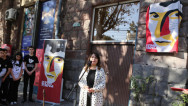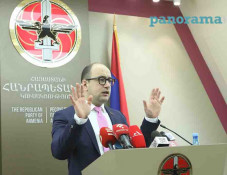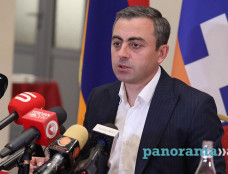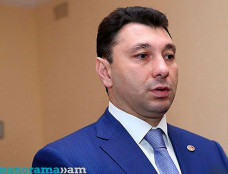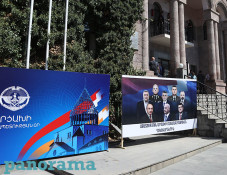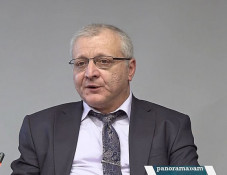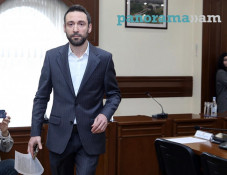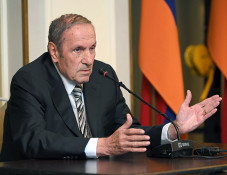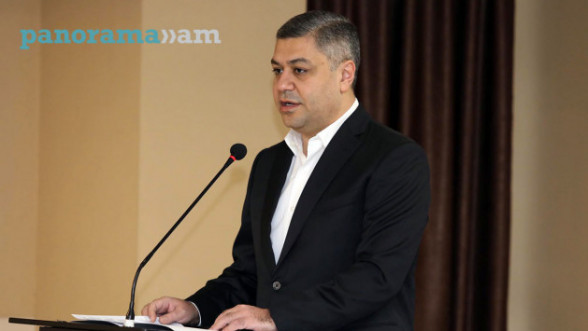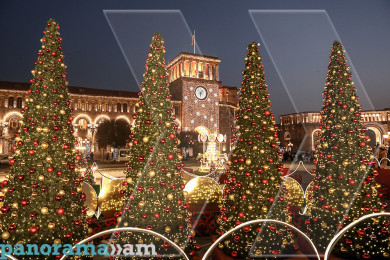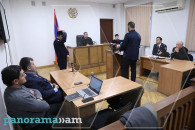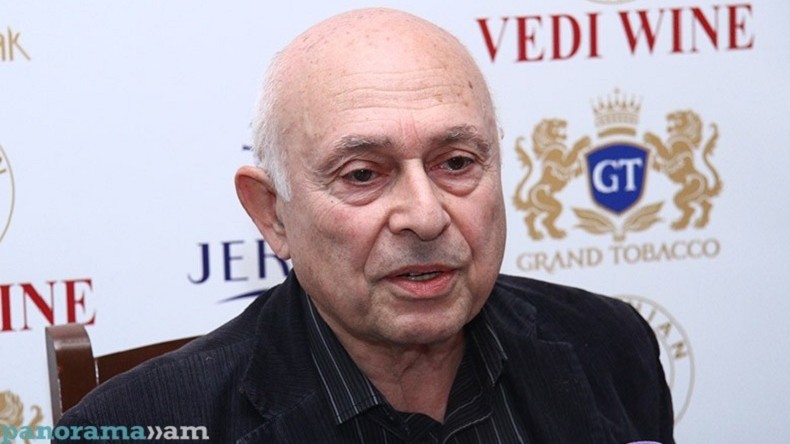
Rouben Galichian: Armenia and South Caucasus in early medieval cartographers’ works
In his book Historical and Geographical Falsifications of Azerbaijan, a historical, cultural and cartographical research based on a detailed analysis backed by documentary evidence, famous cartographer Rouben Galichian reviews several maps from the Geography by Claudius Ptolomaeus (90-168 CE), known as Ptolemy, compiled based on his cartographic and geographic writings.
“None of Ptolemy’s original maps have survived but since the 1470s various Italian, German, Spanish, French, English and Swiss cartographers have prepared maps based on the descriptions and tables he has provided in the Geography. The tables contain more than 8,000 names and geographical coordinates of cities and towns, as well as the names of countries, lakes, seas, oceans, mountains and rivers. His tables use the Classical Greek toponyms, most of which today sound unfamiliar and differ from the current ones,” Galichian writes.
The first map discussed in the Geography is the ‘World Map’. Its manuscript version was prepared by the German cartographer Martin Waldseemuller (1470-1520) and was published in Strasbourg in 1513. Only major countries are mentioned and named on this map, no boundaries are shown. On a section of the map, the area of the Near East can be seen with the Caspian Sea on the right, the Black Sea (Pontus Euxinus) top left and between the two we note Armenia Maior and to its left, west of the River Euphrates, Armenia Minor. Albania is north of Armenia; Media is south-east of Armenia, and Assyria and Mesopotamia are to the south. The name of Azerbaijan does not appear here as no country with that name existed yet, Galichian explains.
A Ptolemy map showing Armenia and the neighbouring countries is titled ‘Third Map of Asia. Map of Colchis, Iberia, Albania and Armenia Maior’ in Geography. It was restored by Leonard Holm, who published his version of Ptolemy’s atlas in Ulm, Germany, in 1482.
“The first three countries are situated to the South of the Caucasus Ridge, between the Caspian and Black Seas. Armenia is to the south of those countries. The territory south-east of Armenia is marked Media pars (‘part of Media’) as the names ‘Azerbaijan’ or ‘Atrpatakan’ were not in common use in Ptolemy’s times. The eastern outskirts of Armenia Minor are at the left of the map,” Galichian writes.
Next, Galichian presents a rare map by Ptolemy, which combines Greater and Lesser Armenias on a single sheet taken from Bononie’s Atlas of 1482 published in Rome. “The Caspian Sea is on the right upper corner of the map, Albania, as well as Iberia and Colchis are on its western coasts. A part of Media can be seen to the south of the Caspian. The main part of the map is dedicated to Armenia Maior and Armenia Minor and shows numerous cities. Cappadocia lies to the west of Armenia,” Galichian writes.
He points out that Armenia Maior and Armenia Minor are present on all the maps described and drawn by Ptolemaic scholars, as are the countries of Albania and Media, proving beyond doubt that the last two were distinct countries and had no ties or relations other than neighbourhood, while the name ‘Azerbaijan,’ which has a 5000-year-long history as per Buniatov, is not to be found on Ptolemy’s maps.
Next, Galichian writes about St Hieronymous or St Jerome (340-420) who translated the Chronicon of Bishop Eusebius of Caesaria (260- 340) from Greek into Latin. This book contains the toponyms of the Bible, complete with their descriptions. It is one of the most significant early medieval works of geography. In addition to the names of towns and toponyms, it contains two manuscript maps compiled in the 5th century. In the appendix of his book, Galichian presents St Jerome’s map of Middle East and South-Eastern Europe drawn in 420 CE, but the image is that of a 12th century copy of the map.
“Armenia is situated between the Caspian and Black Seas, and there is a legend reading ‘Armenie pile’ – meaning ‘Pillars [gates] of Armenia’ – here on a mountain ridge. Armenia Superior (Greater) is on the left. The sources of Araks, Euphrates and Tigris are in these very mountains, the former originating from the north of the mountains, and the other two from the south. That ridge can be a part of the geographic region later referred to as the Armenian Highlands, as those rivers originate from that same highland. On the map, Armenia Superior (Greater) is situated by the sources of the Rivers Tigris and Euphrates, between them, that is, in Vaspurakan, Ayrarat, Mokq and Aghdznik. Below the legend ‘Armenian Superior,’ a hipped roof house named ‘Area Noe’ (Noah’s Ark) is drawn on the top of a mountain, which is inscribed ‘Armenia.’ The mountains are on the southern outskirts of another ridge. It is named Caspian Gates, but the name is wrong as those are not gates but mountains which can be nothing else but the Haykakan Par (Armenian Dance), a mountain ridge beginning from Ararat and stretching to the west. There is another perpendicular note reading ‘Caspian Gates’ above the Pillars of Armenia (to the east). It probably denotes Chora Pahak, a mountain pass between the eastern end of the Caucasian Ridge and the seaside town of Derbent. However here, it is situated in the centre of an unnamed ridge, which can only be the Greater Caucasus Range, often called Caucasus Gates. The way passing through Derbent was often called the Gates of Alexander, as it was founded by Alexander the Great to defend the South Caucasus from the warlike northern tribes of Gog and Magog, according to the legend. Armenia Inferior or Minor is situated to the west of the ridge Haykakan Par,” Galichian describes.
On St Jerome’s map, Albania (Aghvank) is situated to the west of the Caspian Sea, near the Upper Skythia and to the north of Araks, while Colchis (Abkhazia) lies on the eastern coasts of the Euxine Sea. Georgia, named Iberia on the map, is situated on the bank of Araks.
“There are several minor topographic mistakes on the map, but what is important is that Armenia, Aghvank and Colchis are distinctly shown on the map among the geographic data, towns, countries and lands. Aghvank is situated to the north of Kura, while the name Azerbaijan is not mentioned at all,” Galichian highlights.
He next refers to Paulus Orosius (354-420), a historian and theologian born in Portugal. His most renowned work is the Seven Books against the Pagans composed around 416-417 CE, of which some 200 copies have reached us. The book contains the world history from the Creation to his days, altogether some 5,618 years. “Although none of the extant manuscript copies contain any maps, the presence of three hundred toponyms and their descriptions in the text implies one,” Galichian writes.
In his discussion of countries and nations, Orosius says: “... beginning from the Euphrates, west of which is the Mediterranean and in the north—the mountains called Taurus—there is a land which is called Armenia. ... To the north of these mountains is Cappadocia and to its east is Armenia.”
The German cartographer Konrad Miller reconstructed Orosius’s map and notes the mentioned three countries in the land lying to the south of the Caucasus Mountains. Albania is noted by the Caspian gates on the north of the Caucasus Mountains. The mountain ranges that cross Armenia and are situated to the south of it are named Armenian and Taurus. Armenia is noted by them; Parthia is to the south of Armenia and mountains called Mons Ariobarzanes (Mountains of Ariobarzanes/Atrpatakan) are situated near it. Media is noted a little more south. “Thus, according to Orosius, Armenia, Aghvank and Media, whose northern part later received the name Atrpatakan, were situated in this territory in the early middle ages,” Galichian notes.
To be continued.
Born in Tabriz, Rouben Galichian is a descendant of refugees from Van who survived the Genocide. He received scholarship and studied engineering at Aston University, Birmingham (UK). Since in 1981, he started to study the rich cartographical heritage in the libraries of the UK and other European countries. His first research, Historic Maps of Armenia (in English), was published in 2004. It was a collection of maps from various libraries and museums in the world, where Armenia was noted, beginning from the 6th century to the present times. His second book, Armenia in World Cartography, was published in Yerevan in 2005. The research ‘Countries South of the Caucasus in Medieval Maps. Armenia, Georgia and Azerbaijan’ (in English and Armenian) was published in 2007. The book The Invention of History (in English) was published in 2009.
In his book Historical and Geographical Falsifications of Azerbaijan, published in 2013, the author details the reasons, aims and methodology of the falsification of the history of Azerbaijan and the countries of the region.
Related news
- Rouben Galichian: Name Hayastan, Armenia or Ermeniye can be seen practically on all European and Islamic medieval maps
- Rouben Galichian displays Azerbaijanis appropriating written culture and famous individuals of neighbouring peoples
- Rouben Galichian references Medieval Christian travellers and chroniclers’ evidence on Armenian presence in Caucasus
- Rouben Galichian exposes Azerbaijani scholars’ falsifications of their own sources about Armenia and Armenians
- Rouben Galichian references C9-14th Islamic sources about Armenia and Armenians
Newsfeed
Videos




